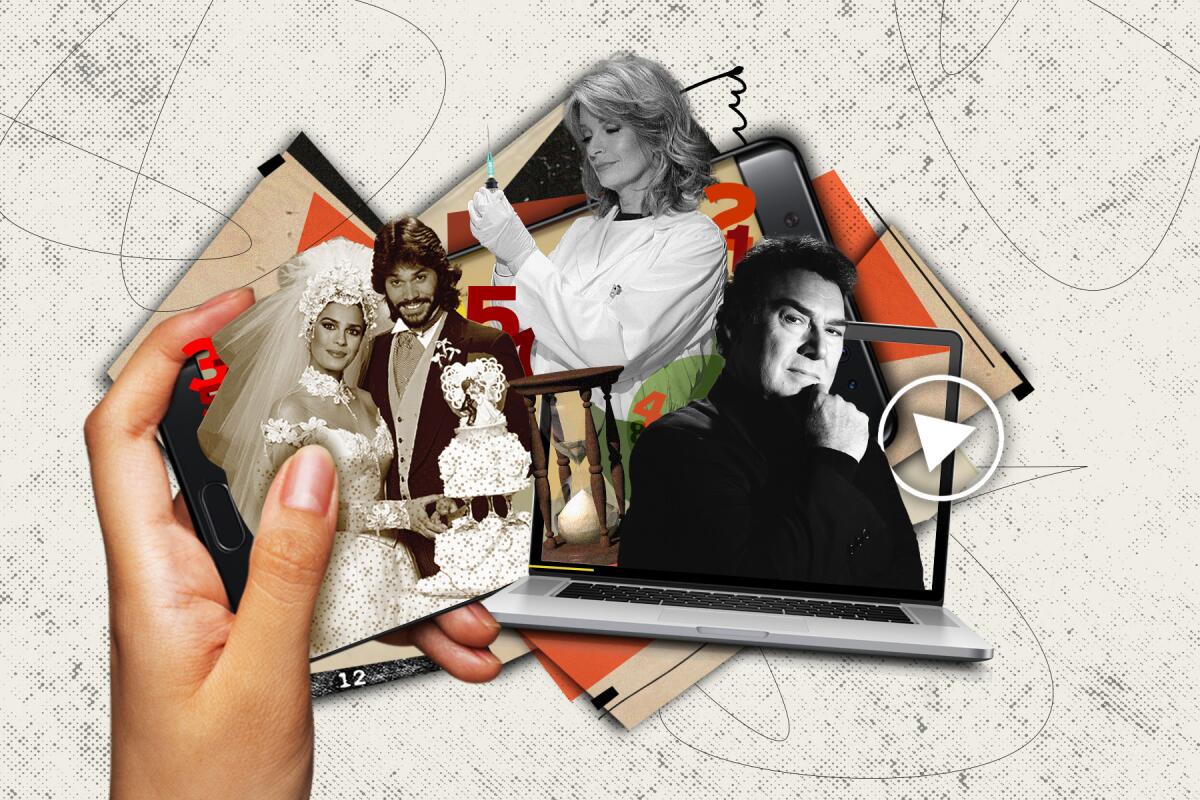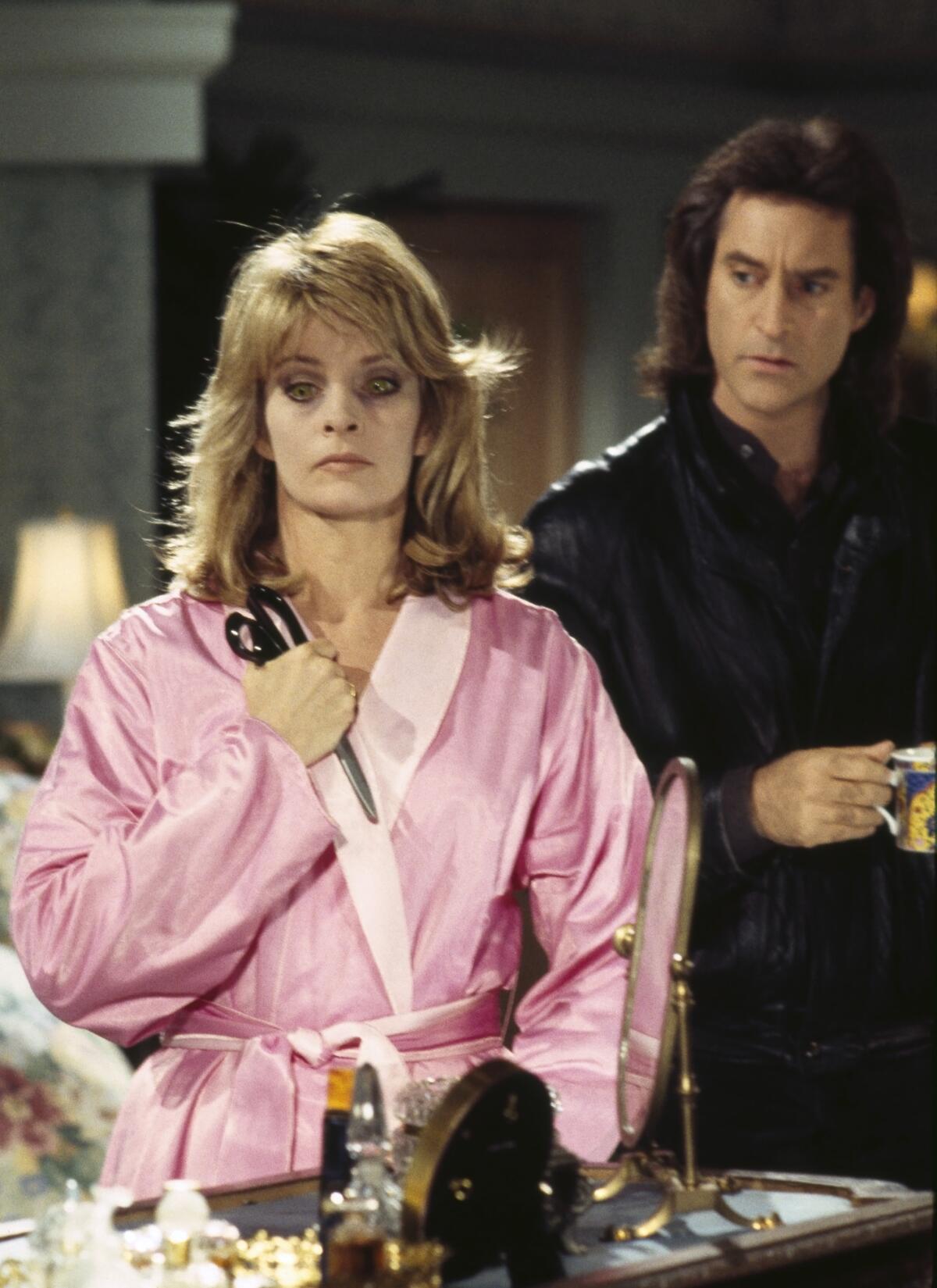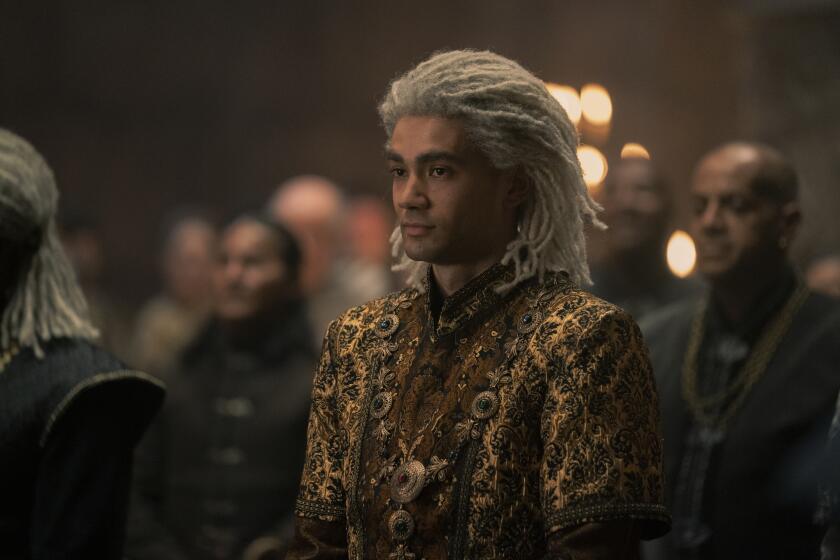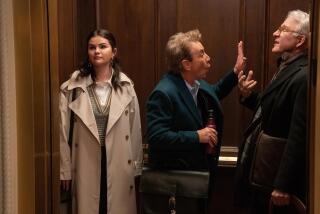‘Days of Our Lives’ made the move to streaming. Some loyal fans are feeling burned

For 57 years and more than 14,000 episodes, fans of “Days of Our Lives” have tuned in each weekday to see what calamity will befall the tiny but unusually eventful Midwestern town of Salem.
There was the time Carly Manning was buried alive by her romantic rival, Vivian Alamain.
The time Stefano DiMera planted a microchip in Hope Brady’s brain to make her believe she was an international art thief named Princess Gina.
And the time — sorry, two times — Dr. Marlena Evans was possessed by the devil.
The complete guide to home viewing
Get Screen Gab for everything about the TV shows and streaming movies everyone’s talking about.
You may occasionally receive promotional content from the Los Angeles Times.
But last week, the daytime drama took a leap that many longtime viewers may never accept: NBC moved the soap, a staple of its daytime programming since 1965, to Peacock, NBC Universal’s streaming service, replacing it with a daily news broadcast. From now on, new episodes of “Days” will be ready to view on demand each weekday at 6 a.m. Eastern. (In a final indignity for some viewers on the East Coast, NBC cut away in the final two minutes of the show’s last linear broadcast on Sept. 9 to air a pre-recorded address from King Charles III about the death of his mother, Britain’s Queen Elizabeth II, the previous day.)
Announced with little fanfare last month, the news that “Days” would live on as a streaming exclusive was not as surprising as, say, the time a completely unrecognizable Roman Brady reappeared in Salem years after he was presumed dead.
“Days” was the least-watched of the four daytime soaps remaining on broadcast TV, and it has endured numerous budget cuts as its ratings dwindled. Still, its audience is loyal and, by the fragmented standards of 2022, significant: It drew around 1.7 million viewers to NBC each day (roughly the same number of people who tuned in to the Season 3 finale of HBO’s much-lauded “Succession” on the day it ran). Peacock had already tested the digital waters with two installments of a spinoff, “Beyond Salem,” which proved that at least some of the “Days” fan base could be lured to a new platform.
“The writing has been on the wall for quite a while, at least two years, that the future of dramatic broadcast television will be behind the paywall on streaming venues,” said executive producer Ken Corday, whose parents, Betty and Ted Corday, created “Days,” one of the first soaps to air in color and expand to a 60-minute format.
He sees the transition to digital as the latest evolution for a medium that began on radio before migrating to broadcast TV. “As things change, you either adapt with them or you get left behind,“ he says. ”And ‘Days’ has always been good at pioneering change.”
While some fans welcome the move as a vital lifeline for their beloved soap, many other longtime viewers, particularly older ones, are outraged. They balk at the idea of paying for something that was once available for free over the airwaves. They may be intimidated by new technology or lack the funds for a smart TV or tablet. They feel as though after decades of unstinting loyalty, they are being abandoned by entertainment conglomerates desperate to woo elusive younger audiences. And, perhaps most of all, they resent the disruption of a cherished daily ritual during a time of dizzying change.
Trish Hobbs, 60, has been watching “Days” since she was 9. (Her German grandmother, a soap fanatic, got her hooked.) As a stay-at-home mom, she timed her kids’ naps so she was free to tune in each afternoon to hear Macdonald Carey’s voice in the iconic intro: “Like sands through the hourglass, so are the days of our lives.”
Until Sept. 9, Hobbs, who lives in North Carolina, continued to plan her days around “Days.”
“I’m divorced. I live alone. It’s like friends coming over,” she said, likening the show to a comforting plate of macaroni and cheese. Through her cable provider, she was able to get a free Peacock subscription and has been watching the show on her desktop computer the last few days — “but it’s not the same,” she said wearily. Hobbs, a cancer survivor, is not able to work and can barely afford to see her doctor, so she’s not sure what she’ll do when the free subscription runs out.
Bravo’s glittery reality franchise has always encouraged competitive consumption. But cast members’ financial ‘smoke and mirrors’ can lead to trouble.
“I already have to pay for cable to get my TV. Now you want me to pay to watch my show on an app that I don’t fully understand, that I don’t have the money to pay for and I probably won’t watch anything else on?” she said. “They’re discounting the people that made the show what it is.”
Yolanda Viviani, 83, has been watching “Days” since she was a young mother in New York City in the 1960s. When she and her husband eventually moved upstate and opened a bar, she’d sometimes flip the TV over to “Days,” irritating customers who preferred sports.
“I’m really disappointed with what they did. It’s unfair,” said Viviani, who now relies on her daughter or grandchildren to turn on Peacock using several different remotes. “A little more independence taken away.”
Producers have been promoting the move with short clips on social media featuring favorite cast members. One, starring 97-year-old Bill Hayes and his 79-year-old wife, Susan Seaforth Hayes, was squarely aimed at older, technophobic viewers.
“We need to tell our loving and loyal fans, ‘Come on, we’ve got you.’ Take them by the hand and bring them over,” said Deidre Hall, who began playing Marlena Evans, a psychiatrist who has endured enough trauma to spend a lifetime in therapy, in 1976. “Nobody’s saying it’s not a change, and we’re all a little uncomfortable with change. But it’s a good thing.”

Daytime TV is inherently habit forming “because we never give you any relief,” Hall said. “There’s always something you’ve got to know the answer to.” But “Days” is unique in the way it has followed the same families — the Bradys, Hortons, DiMeras and Kiriakises — for decades. It may be bonkers, but it’s a familiar bonkers.
“We’re having such hard years lately. So many people have been stuck at home, and our show is a tremendous comfort. They know us, they love us, they trust us,” Hall said.
In its early years, the serial was known for its bold yet intimate storylines, including a groundbreaking interracial romance in the 1970s. Over time, “Days” embraced more outrageous plots involving doppelgängers, brainwashing and characters that came back from the dead with alarming regularity — a campy streak that “Friends” spoofed via Joey’s breakout role as a neurosurgeon revived by a brain transplant.
“When you turned on ‘Days,’ it was so strikingly different than any other show. It was the eye candy of the soap genre, it was shirtless hunks, locations like New Orleans, devil possessions and larger-than-life weddings. It was truly on its own,” said Casey Hutchison, 22, who learned about the show’s history through commemorative books acquired at thrift stores and whose love of the daytime genre inspired him to create an audio soap called “Forever and a Day.” “It knows the type of crazy show it is, and it’s always going to be that.”
Incest is common. Dragons rule the skies. But gay men are unacceptable? Here’s a look at the franchise’s problematic history with LGBTQ representation.
Even at its most over-the-top, “there was still some nuance about it,” a kernel of emotional truth that kept the madness grounded, said Troy Thompson, 36, from Milwaukee, who started out watching every day after school with his mother and grandmother. “Especially being a young, Black gay boy, there were times where I felt more comfortable with these characters than people in my real life. I was able to get lost in it.”
Thompson is sympathetic to older people frustrated by the switch to Peacock but believes that younger fans like himself need to help out however they can. “Yes, inflation is high. We all have our issues. But if you can go get a pack of Newport 100s, you can make damn sure your grandma gets to watch Marlena Evans.”
Some “Days” devotees are doing just that. Using her Twitter account @hourglassfan, Clare Kilgallen, 52, has been trying to raise awareness among fans about how to sign up for Peacock and avail themselves of a promotional deal allowing new subscribers to get a full year of the service for $20 throughout the month of September. She hopes that, over the coming weeks, NBC will make a robust attempt to reach viewers who tune into the show’s old time slot. “It’s really important to let people know where they’ve gone,” said Kilgallen, who even warned her local library to brace for calls from seniors looking for tech support. “It’s like, go help your neighbor.”
Others have gone to even more extreme lengths: The weekend before “Days” permanently relocated to Peacock, Elizabeth Capobianco, 35, flew to New York from North Carolina to help her 81-year-old grandmother set up the streaming service. She worries about people in nursing homes or in rural locations without access to high-speed internet.
“They’re going to lose so many of these grandmothers that have been watching since the very beginning,” she said. “But the flip side is, ‘Thank God they’re not canceled.’ Because that was the alternative.”

There are other advantages to the streaming model beyond mere survival: preventing the constant pre-emptions for breaking news, the possibility of edgier content, longer episodes without so many ad breaks. There might even be an opportunity to attract new fans (and thrill existing ones) with access to classic episodes of “Days” gone by. “While there are no plans at this time, it’s our sincere hope that we will be able to give fans access to old episodes and footage in the future,” said Corday.
But daytime drama flourished in a cultural and social climate that is now unrecognizable. American TV’s remaining soaps — “Days,” “General Hospital,” “The Young and the Restless” and “The Bold and the Beautiful” — face significant challenges. The homemakers who once made up the daytime audience are an endangered species — and have been for decades. Their kids are hooked on TikTok, not their mom’s intricate and slow-moving “stories.”
Viewers with a taste for family intrigue and messy love triangles have countless other diversions at their fingertips, including reality TV like “The Real Housewives” and the nonstop churn of celebrity gossip on social media. Even glossy scripted sagas like “Yellowstone” and “The Crown” offer juicy family melodrama dressed up with higher production values.
In the end, “Days’” most formidable villain isn’t any of the scheming DiMeras. It’s a viewer with too many options and not enough time.
More to Read
The complete guide to home viewing
Get Screen Gab for everything about the TV shows and streaming movies everyone’s talking about.
You may occasionally receive promotional content from the Los Angeles Times.








